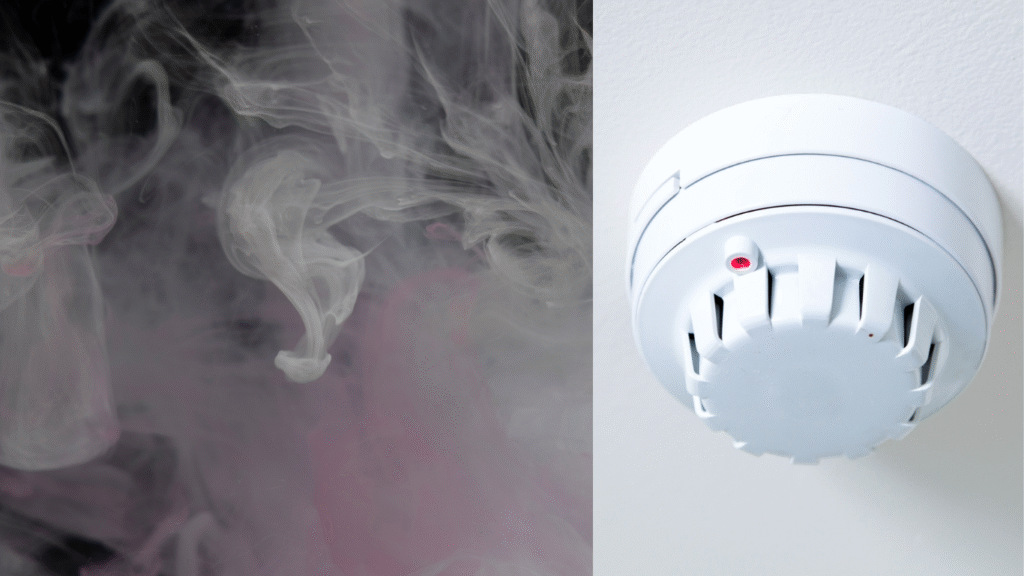If you’ve ever been startled by a smoke detector beeping out of nowhere, you’re not alone. That chirping sound can be annoying, but it’s your smoke detector’s way of grabbing your attention. Smoke detectors are lifesavers, designed to alert you to fire or smoke, but when they start beeping for no clear reason, it can drive you up the wall. Understanding why it’s happening and how to fix it is key to keeping your home safe and your sanity intact.
The beeping usually means something’s up, like a low battery, dust buildup, or a malfunction. Ignoring it isn’t smart since a faulty detector might not work when you need it most. Plus, that noise isn’t going to stop on its own. This article will walk you through why smoke detectors beep, how to troubleshoot common issues, steps to stop the noise, maintenance tips, and when it’s time to replace the device. Let’s dive in and silence that chirp while keeping safety first.
Why Is Your Smoke Detector Beeping
Smoke detectors beep for a handful of reasons, and figuring out the cause is the first step to fixing it. The most common culprit is a low battery. Most detectors chirp every minute or so when the battery is dying, usually a 9-volt or AA. If it’s a 10-year sealed model, the whole unit might need replacing.
Another reason could be dust or debris inside the detector. Over time, tiny particles can mess with the sensors, triggering false alarms or chirps. High humidity or temperature changes in places like bathrooms or kitchens can also set it off. Some detectors are sensitive to steam or cooking fumes, causing random beeps.
A less common issue is a wiring problem in hardwired models. Loose connections or power surges might make it chirp. If the detector is old – say, over 10 years, it could be signaling it’s time to retire. Check the manufacture date on the back.
Sometimes, it’s an actual alert. If there’s smoke or carbon monoxide (for combo units), the beeping might be a real warning. Always check for hazards first. Knowing the cause helps you decide whether to replace a battery, clean the unit, or call a pro for wiring issues.
Troubleshooting Common Smoke Detector Issues
When your smoke detector starts beeping, don’t just yank the battery out – troubleshoot smartly. First, ensure there’s no real danger like smoke or fire. If it’s clear, press the test/reset button to hush the alarm temporarily. If it keeps chirping, it’s likely not an emergency but a maintenance issue.
Check the battery. For battery-powered units, pop open the cover and swap in a fresh one – use the type recommended by the manual, usually a 9-volt or AA. For hardwired detectors, ensure the backup battery isn’t dead. If the chirping continues, it might be dust. Gently vacuum the unit with a soft brush attachment to clear out debris.
Test the environment. If it’s near a kitchen or bathroom, steam or heat might be the issue. Consider moving it a few feet away from these areas, following NFPA guidelines – 10 feet from cooking appliances is ideal. For hardwired models, check for loose wiring or power issues; you might need an electrician for this.
If the detector is over 10 years old, it’s likely past its lifespan. Look at the manufacture date and replace it if needed. Test after each fix by pressing the test button to confirm it’s working. If nothing stops the beeping, consult the manual or contact the manufacturer for model-specific advice.
Steps to Stop the Beeping
Ready to silence that annoying chirp? Follow these steps to stop your smoke detector beeping while keeping it functional. First, rule out any real danger – check for smoke, fire, or carbon monoxide. If it’s safe, press the hush or reset button to pause the alarm for a few minutes.
Next, replace the battery. Open the detector’s cover, remove the old battery, and pop in a new one, matching the type listed in the manual. Test the unit by pressing the test button; it should sound a loud alarm. If it still chirps, clean it. Use a can of compressed air or a vacuum with a soft brush to remove dust from the sensors.
For hardwired detectors, check the power. Ensure it’s properly connected, and replace the backup battery if needed. If the beeping persists, reset the unit by turning off power at the breaker for a minute, then turning it back on. Relocate the detector if it’s too close to a kitchen or bathroom.
If the device is old or still won’t stop, replace it entirely. Buy a new one that matches your needs – battery-powered or hardwired – and install it following local codes. Always test after each step to confirm the fix. If you’re stuck, call a professional to check wiring or advanced issues. These steps should quiet things down fast.
Maintaining Your Smoke Detector
Keeping your smoke detector in top shape prevents random beeping and ensures it works when needed. Start with regular battery checks. Replace batteries once a year, even if they’re not dead, to avoid low-battery chirps. Mark your calendar – many use daylight savings time as a reminder.
Clean your detector every six months. Dust and bugs can mess with sensors, so gently vacuum the exterior and vents with a soft brush or use compressed air. Avoid sprays or liquids that could damage the unit. For hardwired models, check connections yearly to ensure they’re secure.
Test monthly. Press the test button to confirm the alarm sounds loudly. If it’s weak or silent, replace the battery or unit. Check the manufacture date – most detectors last 8-10 years, so swap out old ones even if they seem fine. Combo units for smoke and carbon monoxide need the same care.
Place detectors wisely: one on every floor, outside sleeping areas, and at least 10 feet from kitchens or bathrooms to avoid false triggers. Follow local fire codes for placement. Keep a record of maintenance to stay on track. Regular care takes just minutes but ensures your detector is ready to protect you without those pesky chirps.
When to Replace Your Smoke Detector
Knowing when to replace your smoke detector is crucial for safety. Most units have a lifespan of 8-10 years, so check the manufacture date on the back. If it’s older than that, swap it out, even if it seems to work. Sensors degrade over time, reducing reliability.
Replace it if it keeps beeping despite new batteries, cleaning, or relocation – it’s likely faulty. For sealed 10-year models, don’t try to replace the battery; get a new unit when it starts chirping. If the test button doesn’t trigger a loud alarm, that’s another sign it’s done.
Consider upgrading if your detector lacks modern features like carbon monoxide detection or smart alerts that send notifications to your phone. Newer models are often more sensitive and less prone to false alarms. If you’re renovating or moving, ensure detectors meet current codes, which might require hardwired units with battery backups.
When buying a replacement, choose a reputable brand like First Alert or Kidde, and decide between ionization (better for fast flames) or photoelectric (better for smoldering fires). Combo units cover both. Install it properly, following instructions, and test it right away. Replacing old or faulty detectors keeps your home safe and stops those annoying beeps for good.
To wrap up, a beeping smoke detector is trying to tell you something. Whether it’s a quick battery swap, a good cleaning, or time for a new unit, tackling the issue keeps your home safe. Take action fast, stay on top of maintenance, and you’ll have peace of mind without the chirping chaos.
FAQs
Why does my smoke detector beep randomly?
It’s usually a low battery, dust buildup, or sensitivity to humidity or heat. Check the battery and clean it first.
How often should I replace the battery?
Replace batteries yearly, even if they’re not dead, to prevent chirping. Use the type recommended by the manual.
Can I silence a beeping smoke detector?
Yes, press the hush button to pause it temporarily, but fix the issue – low battery, dust, or age, to stop it permanently.
When should I replace my smoke detector?
Replace it every 8-10 years, if it keeps beeping after troubleshooting, or if it fails the test button check.
Where should I place smoke detectors?
Install one on every floor, outside bedrooms, and at least 10 feet from kitchens or bathrooms to avoid false alarms.



